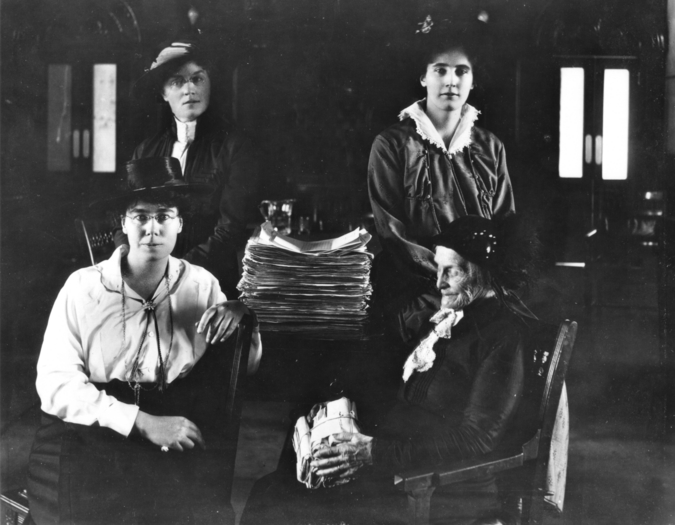This month marks the centennial of women in Manitoba getting the vote (January 28, 1916), and the Manitoba Museum is one place celebrating this. I took in the exhibition “Nice Women Don’t Want the Vote” last week (it runs to April 10, and tours after that), and was pleased to see that the famous but possibly incorrect quotation attributed to suffrage leader Nellie McClung is not at the forefront of the exhibit. That quotation is “Never retract, never explain, never apologize – get the thing done and let them howl.” It’s a great little outburst, but I can’t trace it properly to McClung’s actual speeches or writings. Apparently lots of people uttered versions of this in the nineteenth century.
My favourite McClung quotation is this one, from her 1915 book In Times Like These: “The men tell us with a fine air of chivalry that women should not be given the vote because women don’t want the vote, the inference being that women get nothing unless they want. Women get a lot of things they don’t want – the war, the liquor traffic, and lower pay for equal work.”
There are plenty of feisty quotable bits in the McClung repertoire without resorting to something she may not have said. I like McClung, who lived in Winnipeg’s Wolseley area at 97 Chestnut Street, a short walk from where I live today, and I like having her as a neighbour. I also like Amelia Burritt, who, at 93, gathered 4,000 signatures for the 1915 petition presented to the Legislature. She is pictured in my favourite Manitoba women’s suffrage photo, and I was glad to see it reproduced in the exhibit. (See featured image: Amelia Burritt at bottom right, and then, clockwise, Dr. Mary Crawford, Winona Flett Dixon, and Lillian Beynon Thomas. Source: Manitoba Archive.)
It’s the relatively casual look of their hats and clothes that catches my eye. Photographs from the nineteenth and early twentieth centuries often come across as overly formal; we tend to think of everyone back then as severely buttoned up and coiffed within an inch of their lives. These four women (with the exception of Dixon, who does look rather buttoned up), seem like real people. They wear hats and slightly elaborate collars because they have to, but for the most part they want to get moving with the task at hand.
I came across some photos new to me. I was tickled by the one captioned “Elizabeth Davis and three daughters (and pig) ca. 1919” in the “Portraits of Manitoba Women” section. The youngest daughter is seated on the enormous pig, supported by the next-oldest, and they all look very jolly. The pictures from a picnic (circa 1912) of the Roaring River Suffrage Association are also grand. There were, I’m happy to see, a lot of male members of this lively group, from the Swan River area.
Visitors are encouraged to write messages that are then posted on the exhibit’s wall. One question posed is about issues for women today that still need to be addressed, and the comments, mostly from schoolchildren, are moving. While I was there, however, kids swept in and spent an average of twenty seconds in the room. They were mostly fascinated by the gas mask, hardly central to the suffrage message, from the Great War. Yet in the corridor I heard the voice of one boy plaintively call out: “Guys, take your time! Read stuff!” The adult chaperones trailed after, a long way back.
Wondering what a “nice” woman was anymore, and if I would ever have wanted to be one, I noted another discrepancy, not unlike the misaligned McClung “let them howl” quotation. The main promotional image for the exhibit features Mae Irene Whyte, looking jaunty and mannish in a 1912 photo that shows her wearing a tie and holding a cigarette. But (as I read the material in the exhibit more carefully than the kids who had torn off down the hall), I found this non-traditional outfit was for a “burlesque” that Whyte attended. She regularly wore conventionally feminine clothes, and there’s a photo to prove it. And then my eye fell on the large display of Whyte’s hand-painted porcelain. Not exactly iconoclastic. I’m afraid I heaved a sigh and may have muttered a word that was not very “nice.”
As I left, I noted a pledge card from the WCTU (Women’s Christian Temperance Union), arguably the most important prairie women’s organization ever. They worked hard for women’s rights, for which I am very grateful. But if I would have signed up back then, I would have been promising not only to renounce alcohol, but also swearing. Oh well.
***
Aside from living in Winnipeg’s Wolseley area with the other crackpots and professors, Sue Sorensen teaches English at Canadian Mennonite University and wonders if she would be any good at sitting on a pig. She knows she wouldn’t be good at hand-painting porcelain.
